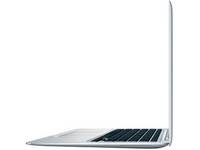Hot, hot Air

I can't say I ever thought a laptop was too heavy or bulky — or genuinely inconvenient — because I couldn't effortlessly slide one into an unpadded manila envelope.
In the countless reflections I've had on the state of the computer industry, the subject of laptop bulkiness has hardly surfaced.

But then there was the Apple keynote in January. It somehow touched a feeling deep within me, so deep I didn't even know it was there. Of course I need a stupidly thin laptop. I need it so much that I want to sacrifice features I hadn't even realised I didn't need anymore.
Sure, some of the big laptops are more than four kilos (which to me says two big bottles of milk), a totally uncivilised weight to forever carry around if you're on the road as much as I am.
But I get the feeling it's not just the jetsetters getting excited about the MacBook Air — I'd say there are currently thousands of housebound coders frantically rationalising an upgrade to a... slower, smaller computer.
When I say smaller, I mean in it in the ethereal sense. When you start to look at it, what you're getting isn't actually physically much smaller at all — Apple's laptops have been freakishly small for years, they just never focused a keynote on it.
A standard MacBook is 2.75cm high, which, just quietly, you can fit into an envelope.
MacBook in an envelope
At the thickest point there is a 9mm difference in girth between a standard MacBook and the MacBook Air, which isn't even a shoe size. The Air does get as thin as 4mm, but that's actually just this slick taper towards the edges. The clamshell iBook, released last century, was also 4mm wide at the edges.
As far as weight is concerned, upgrading to a MacBook Air will save you 900 grams of travel mass, or the equivalent of a Powerade and Snickers bar.
So what's the compromise for these staggering advancements in space and mass? Going off the Apple Web site, for AU$2,499 I could get a MacBook Air with an 80GB hard drive with a 1.6GHz processor and 2GB of RAM, or opt for the bulky, clumsy MacBook with a 50 percent faster processor, three times as much space, equal memory, and save AU$400 cash. What's more, they'll throw in a DVD-writer, a removable battery, and also some Ethernet, firewire and USB ports.
Now they're off the Air, all those peripherals will be obsolete soon enough. Jobs clearly has something big in mind, and I can't wait to see it.
It's a funny reminder though; over the last decade, Apple devotees (myself included at times) have defended Apple through thick and thin off the back of superior performance. But this time, as we rush out for a slower unit, there's no hiding we were always just there for the cool.